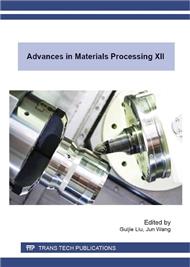[1]
A.T. Abdulsadda, X. Tan, An artificial lateral line system using IPMC sensor arrays, Int. J. Smart Nano Mater. 3 (2012) 226-242.
DOI: 10.1080/19475411.2011.650233
Google Scholar
[2]
E. Chen, J. Guo, Real time map generation using sidescan sonar scanlines for unmanned underwater vehicles, Ocean Eng. 91 (2014) 252–262.
DOI: 10.1016/j.oceaneng.2014.09.017
Google Scholar
[3]
J. Chen, J. Engel, N. Chen, S. Pandya, S. Coombs, C. Liu, Artificial lateral line and hydrodynamic object tracking, IEEE2006, Turkey, 2006, 694-697.
DOI: 10.1109/memsys.2006.1627894
Google Scholar
[4]
T.Y. Hsieh, S.W. Huang, L.J. Mu, E. Chen, J. Guo, Artificial lateral line design for robotic fish, IEEE2011, Tokyo, 2011, 5774165.
Google Scholar
[5]
Y. Yang, N. Nguyen, N. Chen, M. Lockwood, C. Tucker, H. Hu, H. Bleckmann, C. Liu, D.L. Jones, Artificial lateral line with biomimetic neuromasts to emulate fish sensing, Bioinspir. Biomimetics. 5 (2010) 1206.
DOI: 10.1088/1748-3182/5/1/016001
Google Scholar
[6]
R. Venturelli1, O. Akanyeti1, Hydrodynamic pressure sensing with an artificial lateral line in steady and unsteady flows, Bioinspir. Biomimetics. 7 (2012) 036004.
DOI: 10.1088/1748-3182/7/3/036004
Google Scholar
[7]
Y.S. Ryuh, G.H. Yang, J.D. Liu, A school of robotic fish for mariculture monitoring in the sea coast, J. Bionic. Eng. 12 (2015) 37–46.
DOI: 10.1016/s1672-6529(14)60098-6
Google Scholar
[8]
F. Rizzi, A. Qualtieri, Biomimetics of underwater hair cell sensing, Microelectron. ENG. 132 (2015) 90–97.
DOI: 10.1016/j.mee.2014.10.011
Google Scholar
[9]
A. Mansour, Y.K. Aghil, Three-dimensional optimal path planning for waypoint guidance of an autonomous underwater vehicle, Rob. Autom. Syst. 67 (2015) 23-32.
DOI: 10.1016/j.robot.2014.10.007
Google Scholar
[10]
Chambers L D, Akanyeti O, Venturelli R, et al. A fish perspective: detecting flow features while moving using an artificial lateral line in steady and unsteady flow[J]. Journal of the Royal Society Interface, 2014, 11(99): 20140467.
DOI: 10.1098/rsif.2014.0467
Google Scholar
[11]
Asadnia M, Kottapalli A G P, Miao J, et al. Artificial fish skin of self-powered micro-electromechanical systems hair cells for sensing hydrodynamic flow phenomena[J]. Journal of The Royal Society Interface, 2015, 12(111): 20150322.
DOI: 10.1098/rsif.2015.0322
Google Scholar
[12]
Rizzi, F., Qualtieri, A., Dattoma, T., Epifani, G., De Vittorio, M., Biomimetics of underwater hair cell sensing. Microelectronic Engineering 132, 90-97. (2015).
DOI: 10.1016/j.mee.2014.10.011
Google Scholar


